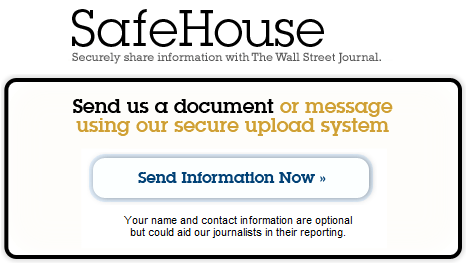 The Wall Street Journal is looking to give WikiLeaks some competition. The publication has launched SafeHouse, which encourages readers to share information concerning “fraud, abuse, pollution, insider trading, and other harms.” Boasting a secure upload system that will encrypt its contents and keep tipsters anonymous, SafeHouse wants to become a mecca for controversial insider information.
The Wall Street Journal is looking to give WikiLeaks some competition. The publication has launched SafeHouse, which encourages readers to share information concerning “fraud, abuse, pollution, insider trading, and other harms.” Boasting a secure upload system that will encrypt its contents and keep tipsters anonymous, SafeHouse wants to become a mecca for controversial insider information.
“If you have newsworthy contracts, correspondence, e-mails, financial records or databases from companies, government agencies or non-profits, you can send them to us using the SafeHouse service,” the site reads. According to WSJ, the site is hosted on secure servers managed for its own editors.
WSJ couldn’t have chosen a better time to introduce SafeHouse. WikiLeaks has struggled since its release of private international cables and the ongoing legal issues surrounding its former leader Julian Assange. The site currently isn’t taking submissions either, “due to re-engineering improvements [to] the site to make it both more secure and more user-friendly.” WikiLeaks was shut down after Cablegate and has since existed on mirror sites.
The New York Times has also been toying with the idea of launching its own WikiLeaks-type service to aid whistleblowers. A Times spokeswoman told Forbes, “We’re continuing to work on it.” SafeHouse will also have some competition from OpenLeaks, former WikiLeaks spokesman Daniel Domscheit-Berg’s project. Domscheit-Berg decided to jump ship with the former site and begin his own as a result of Assange’s tightening grip over the organization.
SafeHouse promises to keep sources anonymous, but does say that using names could help its journalists. It will be interesting to see how this plays out. There’s a chance it could become a goldmine for WSJ, a well-known and trusted publication that knowledgeable, high-ranking insiders may feel more comfortable coming to, versus WikiLeaks or OpenLeaks. As long as it can keep sources confidential and keep its servers safe, it’s never a bad move to try and make the information come to you.


